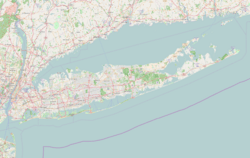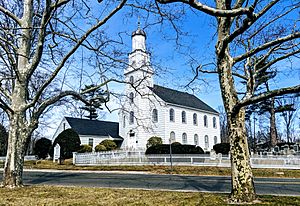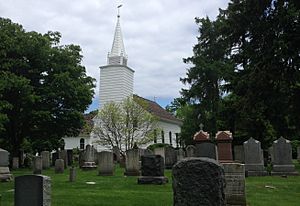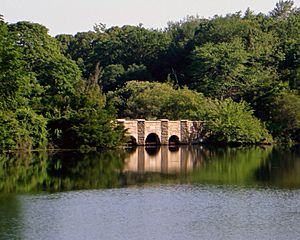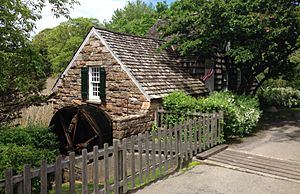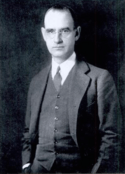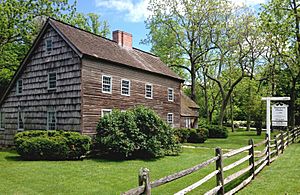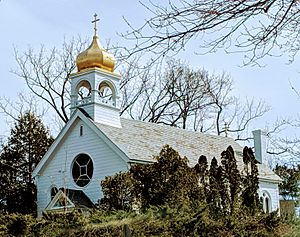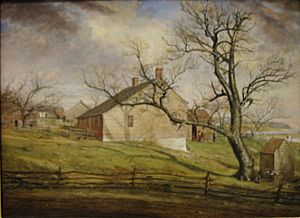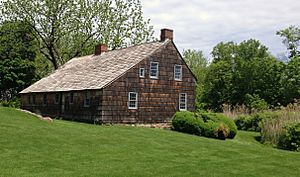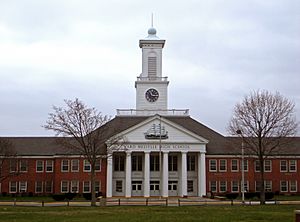Setauket, New York facts for kids
Quick facts for kids
Setauket, New York
|
|
|---|---|
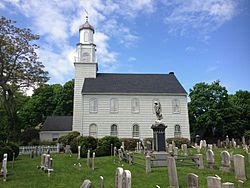
The Setauket Presbyterian Church and Burial Ground, with the graveyard dating to the 1660s and the structure to 1812
|
|
 |
|
| Country | United States |
| State | New York |
| County | Suffolk |
| Town | Brookhaven |
| Area | |
| • Total | 3.28 sq mi (8.49 km2) |
| • Land | 2.52 sq mi (6.52 km2) |
| • Water | 0.76 sq mi (1.97 km2) |
| Population
(2020)
|
|
| • Total | 3,986 |
| • Density | 1,583.00/sq mi (611.18/km2) |
| Time zone | UTC−05:00 (ET) |
| • Summer (DST) | UTC−04:00 |
| ZIP Code |
11733
|
| Area code(s) | 631, 934 |
| FIPS code | 36-66465 |
Setauket (pronounced sә-TAW-kit) is a small community in Suffolk County, New York. It's located on the North Shore of Long Island. In 2020, about 3,986 people lived here.
Setauket was started in 1655. It was the very first settlement in what is now the town of Brookhaven. For a long time, Setauket and East Setauket were counted as one area. But in 2020, they became two separate places.
Long ago, Setauket was a farming community. It became famous during the American Revolutionary War because of the Culper Ring, a secret spy group. Many old buildings in Setauket are still standing today. Setauket is mostly a place where people live. It's close to bigger towns like Port Jefferson and Stony Brook. Many students from Stony Brook University also live nearby.
Contents
History of Setauket
How Setauket Got Its Name
The name "Setauket" comes from the Setalcott Indians. They were an Algonquian-speaking tribe who lived in this area before European settlers arrived.
In 1655, some English settlers from New England bought the land from the local Native Americans. This was the first settlement in the area that would become the town of Brookhaven. Both Setauket and Brookhaven consider 1655 their founding year. In the 1600s, Setauket was basically the same as the colonial town of Brookhaven.
For a short time in the 1660s, Setauket was called "Ashford." This change happened because of Captain John Scott. He was a soldier who helped clear out Native American tribes. Scott was an early settler and an important leader on Long Island. He even claimed to own a third of the island! He renamed Setauket after his family's home in England, Ashford, Kent.
Setauket During the American Revolution
The American Revolutionary War was a big deal in Setauket. In 1777, the Battle of Setauket happened right on the village green. At that time, Loyalists (people loyal to the British King) controlled Setauket. They turned the Presbyterian church into a fort.
A group of Patriots (people fighting for American independence) came from Connecticut. They were led by General Samuel Holden Parsons. They attacked the Loyalists. After three hours of fighting, Parsons' men went back to Connecticut. Not many people were hurt on either side. During the battle, the Patriots hid behind a huge rock called "Patriots' Rock." It's still there today with a special plaque. Some bullets from the fight even hit the walls of the nearby Caroline Church.
From 1778 to 1781, the Culper Spy Ring was active. This secret group of spies sent information about British soldiers in New York City to George Washington. Many of the spies were from Setauket. This included their leader, Benjamin Tallmadge, and a key spy, Abraham Woodhull. The Culper Ring was very successful. They warned Washington about things like a surprise attack on French forces and a plan to make fake money. They also uncovered the secret betrayal of General Benedict Arnold. Later, George Washington even stayed a night in Setauket during his tour of Long Island in 1790.
While the British were in charge, people went to the Caroline Church (built around 1729) for religious services. The British used the Presbyterian church as their fort. They even damaged the pulpit and moved some gravestones to build their defenses. After the war, services started again. The Presbyterian church was rebuilt in 1812 after lightning struck it. Both churches still own the village green today.
Setauket's Modern History
In the 1800s, industries came to East Setauket. Shipbuilding grew, with new shipyards along Setauket Harbor. One famous ship built here was the Adorna in 1870. It was the largest square-rigged sailing ship built on Long Island outside of Brooklyn. A picture of the Adorna is above the entrance of Setauket's elementary school.
Another well-known ship was the Wanderer, built in 1857. It was secretly turned into a slaver (a ship used to illegally transport enslaved people) in Port Jefferson. Local people became suspicious and told the authorities. The ship was caught, but sadly, it was later returned to its owners. It then completed what is thought to be the last successful American trip to Africa to bring enslaved people. The Wanderer later served in the Union Navy during the Civil War.
From 1876 to 1904, East Setauket also had a rubber factory. But by the early 1900s, most of the factories in Setauket had closed.
After 1873, when the railroad came from New York City to Port Jefferson, Setauket became a summer vacation spot. Wealthy families started buying homes along the waterfront.
After World War II, Setauket's population grew a lot. Farmland was turned into new neighborhoods. To protect the old buildings, the Old Setauket Historic District was created. Many homes in Setauket are still from before the war. Historic homes include the Thompson House (built in 1709) and the Sherwood-Jayne Museum (built in 1830). The Frank Melville Memorial Park was started in 1937. It protects much of the land around the Setauket Mill Pond.
A kind person named Ward Melville helped Setauket and nearby towns a lot. He owned a company that became CVS Corporation. Melville founded Stony Brook University, which is right next to Setauket. Some students and teachers from the university now live in Setauket. Melville also helped create a village area in nearby Stony Brook, which is a shopping area for Setauket. East Setauket is also home to Renaissance Technologies, a very successful investment company. It was started by a math professor from Stony Brook University, James Harris Simons.
In 2012, local leaders started planning for the area along New York State Route 25A near Stony Brook University. They want to make it a more walkable downtown area with more businesses.
In 2014, a 3.5-mile (5.6 km) bike path called the Greenway Trail opened. It connects Setauket and Port Jefferson Station. There are plans to make the bike path even longer.
The Greek Orthodox Monastery of the Holy Cross, an important religious center, is also in Setauket.
Geography of Setauket
Setauket is located in the northwest part of the town of Brookhaven. It's on the North Shore of Long Island. It includes parts of two water areas: Setauket Harbor and Conscience Bay. Both of these lead to Port Jefferson Harbor and then to Long Island Sound.
Setauket has a village green, which is a common area like a park. It has a mill pond and a small post office. The Caroline Church (built in 1729) and the Setauket Presbyterian Church (started in 1660) are also here. This area is the historic center of the original settlement. The Emma S. Clark Library, also on the village green, is known as one of the best libraries on Long Island. The mill pond is part of the public Frank Melville Memorial Park.
New York State Route 25A is the main road that goes east and west. It connects Setauket to Port Jefferson and Stony Brook. You can get to Setauket from the Long Island Expressway at Exit 62.
Most of the shops and businesses in Setauket are along Route 25A. There are also some businesses in nearby East Setauket. The rest of Setauket is mostly homes and wooded areas.
"The Setaukets" is a term that refers to a larger area. It includes Setauket, East Setauket, and other nearby places like Strong's Neck and Poquott. Setauket, Old Field, and Stony Brook together form the "Three Village" area. These three communities share the Three Village Central School District.
People in Setauket
In 2020, the population of Setauket was 3,986 people.
Back in 2000, when Setauket and East Setauket were counted together, there were about 15,931 people. Most people were White (about 88%). About 9% were Asian, and about 1% were African American. About 9% of the population was Hispanic or Latino.
Most households were families, with many married couples living together. About 39% of households had children under 18. The average household had about 2.88 people. The median age was 37 years old.
Setauket in Pop Culture
Setauket is the main setting for the TV show Turn: Washington's Spies. This show, which started in 2014, tells the story of the Culper Ring during the American Revolution.
Education in Setauket
The Three Village Central School District serves the Setauket community. Here are some of the schools:
- Arrowhead Elementary School
- Minnesauke Elementary School – "Minnesauke" is an Indian word meaning "Little Neck."
- Nassakeag Elementary School
- Setauket Elementary School
- William Sidney Mount Elementary School – named after a local artist.
- Murphy Junior High School – named after Robert C. Murphy, a local nature expert.
- Paul J. Gelinas Junior High School – named after the first school superintendent.
- Ward Melville High School – named after Ward Melville, who gave land for the school. This school is famous for its science research program. It also has a well-known lacrosse team. Above the main entrance, you can see a picture of the Adorna ship.
- Emma S. Clark Library
- The Stony Brook School (a private school)
- Torah Tots, a Chabad Hebrew school
Media in Setauket
Here are some newspapers that cover Setauket:
- Newsday (daily newspaper)
- Stony Brook Press (Stony Brook University newspaper)
- The Statesman (Stony Brook University newspaper)
- The Village Times Herald (weekly newspaper)
Notable People from Setauket
Many interesting people have lived in Setauket, including:
- Bülent Arel (1919–1990), a composer
- Caleb Brewster (1747–1827), a member of the Culper Ring spy group
- William de Leftwich Dodge (1867–1935), a mural painter
- Louis Edmonds, a Broadway and TV actor
- Mick Foley, a professional wrestler
- Steven Matz, a baseball pitcher
- Ward Melville (1887–1977), a businessman and helper of the community
- William Sydney Mount (1807–1868), a famous painter
- Joseph Reboli (1945–2004), a painter
- Lauren Miller Rogen, an actress and writer
- Ruth Minsky Sender (1926-), a Holocaust survivor and author
- Dee Snider, a singer and radio personality
- Benjamin Tallmadge (1754–1835), a military officer and congressman
- Abraham Woodhull (1750–1826), a main spy in the Culper Ring


